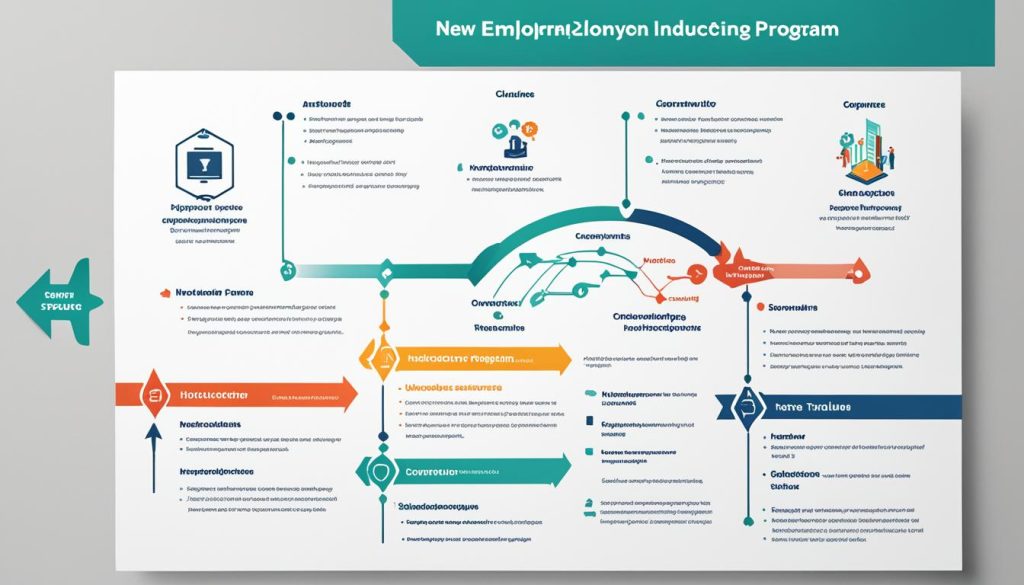Welcome to our comprehensive guide on new employee induction, employee onboarding, staff orientation, and induction programs. In this article, we will explore the importance of a well-planned induction process and its role in ensuring the success and satisfaction of new hires. By the end of this guide, you will have a clear understanding of how to design and implement an effective induction program that sets new employees up for long-term success.
What is New Employee Induction?
New employee induction is the process through which employees adjust and acclimatize to their new jobs and working environment. It involves orienting new employees to the organization, its culture, people, and expectations. Induction includes providing practical information on health and safety, working arrangements, facilities, and role-specific information. It is an opportunity for new employees to understand the organization, their role, and build working relationships. Induction can be a virtual or in-person process, depending on the organization’s needs and the current work environment.
The Importance of New Employee Induction
Effective new employee induction programs are vital for the successful integration and satisfaction of new hires. They provide a solid foundation for new employees to understand the organization, its values, and their role within it. A well-executed induction process also helps new employees develop working relationships with colleagues, fostering a sense of belonging and teamwork. Furthermore, a comprehensive induction program ensures that new employees have the necessary information and resources to excel in their roles, reducing their learning curve and increasing their productivity.
Benefits of New Employee Induction
- Smooth Onboarding: Induction programs allow new employees to smoothly transition into their roles by providing them with crucial information and guidance.
- Improved Employee Integration: Through induction programs, new employees gain a deeper understanding of the company’s culture and values, helping them integrate seamlessly into the organization.
- Enhanced Job Satisfaction: A well-structured induction process boosts job satisfaction by equipping new employees with the necessary knowledge and resources to perform their roles successfully.
- Reduced Turnover: Organizations that invest in comprehensive induction programs are more likely to retain their new hires as they feel supported and valued from the start.
Virtual vs. In-person Induction
With the rise of remote work and hybrid work environments, organizations have adapted their induction processes to be conducted virtually. Virtual inductions utilize video conferencing, online training modules, and electronic documentation to deliver the necessary information to new hires. In-person inductions, on the other hand, allow for face-to-face interactions and immersive experiences within the physical workplace. The choice between virtual and in-person induction depends on the organization’s requirements and the current work environment.
Key Components of a Successful Induction Program
A successful induction program should cover various essential components to ensure new employees are well-equipped for their roles:
| Component | Description |
|---|---|
| Organizational Overview | Introducing new employees to the company’s history, mission, values, and overall structure. |
| Role-specific Training | Providing job-specific information and training to help new employees understand their roles and responsibilities. |
| Introduction to Colleagues and Teams | Facilitating introductions and fostering connections with colleagues to promote collaboration and teamwork. |
| Company Policies and Procedures | Providing information on important policies, procedures, and protocols relevant to the new employee’s role. |
| Health and Safety | Ensuring new employees are aware and well-informed about health and safety regulations and procedures within the workplace. |
| Support and Resources | Offering ongoing support, mentorship, and access to necessary resources to help new employees succeed. |
By incorporating these key components, organizations can create a comprehensive and effective induction program that sets new employees up for success.
The Importance of Employee Induction
Employee induction plays a vital role in the overall success of an organization. It helps new employees feel welcomed, supported, and valued, which contributes to their job satisfaction and engagement. Effective induction can reduce employee turnover and absenteeism, as well as increase employee commitment and loyalty. It provides new employees with the information and resources they need to succeed in their roles and integrates them well within the organizational culture. Employee induction sets the foundation for a positive employment experience and long-term success.

The Impact of Employee Induction
- Creates a positive onboarding experience for new employees
- Helps new employees feel welcomed and valued
- Improves employee job satisfaction and engagement
- Reduces employee turnover and absenteeism
- Increases employee commitment and loyalty
- Integrates new employees well within the organizational culture
An effective employee induction program ensures that new employees have a smooth transition into their roles and the organization. It equips them with the necessary knowledge, skills, and resources to perform their jobs effectively. By introducing new employees to the organizational culture and values, it fosters a sense of belonging and alignment with the organization’s mission and goals.
Furthermore, an effective induction process helps new employees build relationships with their colleagues and establish a support network within the organization. This not only enhances their job satisfaction but also facilitates collaboration and teamwork. By providing new employees with a comprehensive induction program, organizations can set the stage for their long-term success and contribute to a positive work environment.
| Benefits of Employee Induction | Statistics and Findings |
|---|---|
| Reduced employee turnover | Organizations with a comprehensive induction program have a 58% higher employee retention rate. |
| Improved job satisfaction | Employees who receive a structured induction are 69% more likely to stay with the organization for at least three years. |
| Increased employee engagement | Engaged employees who undergo an effective induction program are 87% less likely to leave the organization. |
| Boosted productivity | New employees who undergo a thorough induction program reach full productivity 50% faster compared to those who do not. |
In conclusion, employee induction is a critical component of a successful organization. It sets the stage for new employees to thrive in their roles, fosters a positive work environment, and contributes to overall employee satisfaction and engagement. By investing in a comprehensive and structured induction program, organizations can reap the benefits of reduced turnover, increased employee loyalty, and improved productivity.
Strategic Planning for Effective Induction
Strategic planning is essential for designing an effective new employee induction process. Organizations should consider the specific needs of different employee groups, such as graduate trainees, technical specialists, or senior appointments. By tailoring the induction program to cater to the unique requirements of each employee category, companies can ensure a seamless integration for their new hires.
In the induction planning phase, it is important to identify key elements that will be included in the program. This includes providing comprehensive information on health and safety measures to ensure the well-being of employees, as well as practical information about the working environment to help new staff members navigate their surroundings with confidence.
Moreover, organizations should emphasize sharing the company’s values and culture during the induction process. This allows new employees to align themselves with the organization’s mission and vision, fostering a sense of belonging and enhancing employee engagement.
Additionally, role-specific information should be incorporated into the induction program to equip new employees with the necessary knowledge and skills to excel in their positions. This includes providing clear expectations, job responsibilities and detailed role-specific training that enables employees to contribute effectively to their teams and the organization as a whole.
A well-planned induction program ensures a consistent and positive experience for new employees, setting them up for success right from the start. By addressing the specific needs of different employee groups and covering essential elements in the induction process, organizations can create a strong foundation for employee integration and subsequent performance.

Building a Structured Induction Programme
When welcoming new employees, it is crucial to provide a structured induction programme that ensures a comprehensive and consistent experience. This programme is designed to equip new hires with the necessary knowledge, skills, and resources to integrate successfully into their roles and the organization as a whole. A well-structured induction programme can contribute to employee engagement, job satisfaction, and long-term retention.
Key Elements of a Structured Induction Programme
An effective structured induction programme should incorporate a combination of one-to-one discussions, engaging group learning sessions, and practical activities. By addressing various learning styles, the programme can cater to the individual needs of new employees, enabling them to understand and absorb information more effectively. Key elements to include in the programme are:
- Essential information about organizational procedures, systems, and processes
- Introductions to company strategy, services, and products
- Job-specific information to familiarize employees with their roles and responsibilities
- A guided tour of the premises to provide a sense of belonging and orientation
- Introductions to colleagues and key contacts to facilitate relationship-building
Incorporating these elements into the structured induction programme helps new employees gain a comprehensive understanding of the organization, its values, and its culture. By providing these foundational building blocks, new hires can be better prepared for their roles, enabling them to make meaningful contributions from the start.
| Benefits of a Structured Induction Programme | New Employee Induction Process | Employee Training |
|---|---|---|
| 1. Encourages engagement and commitment | 1. Welcome and introduce new hires to the organization | 1. Equip employees with the necessary skills for their roles |
| 2. Reduces time to proficiency | 2. Provide essential information, procedures, and processes | 2. Enhance employee productivity and performance |
| 3. Improves job satisfaction | 3. Facilitate orientation and integration | 3. Develop a sense of ownership and professional growth |
| 4. Boosts employee retention and loyalty | 4. Establish relationships with colleagues and key contacts | 4. Foster a continuous learning culture |
A structured induction programme also serves as a foundation for ongoing employee training and development. By instilling a culture of learning and growth from the very beginning, organizations can foster employee empowerment and provide opportunities for skill enhancement throughout an employee’s tenure.

Key Elements of Successful Induction
Successful induction programs are essential for ensuring new employees feel supported, integrated, and equipped to thrive within an organization. By incorporating the following key elements into the induction process, companies can lay a strong foundation for new employee success:
1. Providing Practical Information
During the induction process, it is crucial to provide new employees with practical information about the organization. This includes details about facilities and IT systems, organizational procedures, and working arrangements. By equipping new employees with this essential knowledge, they can navigate their roles and responsibilities confidently.
2. Introducing Company Culture and Values
Induction should also focus on introducing new employees to the company’s culture, values, and ways of working. This helps them align with the organization’s mission and goals, fostering a sense of connection and shared purpose. By immersing new employees in the company’s culture from the beginning, organizations can accelerate their integration process.
3. Establishing Relationships and Networks
Encouraging new employees to establish relationships with colleagues and key contacts is vital for their successful onboarding. By facilitating introductions and providing opportunities for networking, organizations can help new employees feel welcomed and supported from day one. Additionally, building relationships fosters collaboration and makes new employees more likely to seek help and advice when needed.
4. Ongoing Support through Mentoring or Coaching
Offering ongoing support through mentoring or coaching is another critical element of a successful induction. By pairing new employees with experienced mentors or providing coaching sessions, organizations can provide guidance, feedback, and professional development opportunities. This support system ensures new employees have the necessary resources to overcome challenges and excel in their roles.
5. Regular Feedback and Check-Ins
To ensure new employees are settling in well and have the necessary support, regular feedback and check-ins are essential. These touchpoints allow organizations to address any concerns, provide additional guidance, and evaluate the effectiveness of the induction process. Continuous communication and support demonstrate that the organization values its employees and is committed to their success.
| Key Elements of Successful Induction |
|---|
| Providing Practical Information |
| Introducing Company Culture and Values |
| Establishing Relationships and Networks |
| Ongoing Support through Mentoring or Coaching |
| Regular Feedback and Check-Ins |
By incorporating these key elements into their induction programs, organizations can ensure new employees feel supported, integrated, and empowered to contribute to their full potential. A comprehensive and well-structured induction process sets the stage for long-term success and helps shape a positive employee experience.

How to Set Up a New Employee Induction?
Setting up a new employee induction requires careful planning and coordination. HR and L&D specialists play a key role in designing, developing, and evaluating the induction process. To ensure a smooth onboarding experience, the induction should begin prior to the new employee’s first day, with the provision of relevant information and documents.
Assigning a mentor or key contact person can help new employees feel supported and connected right from the start. It is also important to prepare the employee’s workspace, ensuring that they have all the necessary equipment and resources.
Scheduling introductions and training sessions with key stakeholders allows new employees to familiarize themselves with the organization’s structure and culture. These interactions facilitate relationship building and provide opportunities for new employees to ask questions and gain clarity on their roles and responsibilities.
An induction checklist is a valuable tool for ensuring that all necessary elements are covered during the onboarding process. It helps HR and L&D teams stay organized and ensures that important information and activities are not overlooked.
Sample Induction Checklist
| Element | Description |
|---|---|
| Preparation | Provide new employee with relevant information, such as a welcome pack, employee handbook, and any necessary forms to complete. |
| Workspace Setup | Prepare the employee’s workspace, including providing necessary equipment, access to systems, and any required training on technology. |
| Introduction to Colleagues | Facilitate introductions to colleagues at various levels within the organization to foster relationships and encourage collaboration. |
| Company Culture | Introduce the new employee to the organization’s values, mission, and key cultural norms to ensure alignment and a sense of belonging. |
| Training and Development | Provide necessary training sessions to equip the new employee with the knowledge and skills required to perform their role effectively. |
| Check-ins | Schedule regular check-ins with the new employee to provide support, address any concerns, and monitor their progress during the induction period. |
Continual evaluation and improvement of the induction process are crucial for its effectiveness. Organizations should gather feedback from new employees and stakeholders to identify areas for improvement and make necessary adjustments to enhance the onboarding experience.
By implementing a well-planned induction process and providing the necessary support, organizations can ensure that new employees feel welcomed, connected, and prepared to contribute to their new roles, ultimately leading to their long-term success.
Conclusion
An effective new employee induction is a crucial step in ensuring the success and satisfaction of new hires. By prioritizing the provision of a comprehensive and structured induction program, organizations can set their employees up for long-term success. The program should cover key elements such as organizational information, role-specific training, and building relationships with colleagues.
HR and L&D teams play a significant role in planning and implementing the induction process. With strategic planning, attention to individual needs, and ongoing evaluation, organizations can create a positive onboarding experience. This experience not only helps new employees integrate into the organization but also boosts employee success and promotes organizational integration.
Investing in a robust induction program demonstrates a commitment to employee support and development. It leads to improved employee satisfaction, increased productivity, and reduced turnover rates. By focusing on effective onboarding and organizational integration, organizations can foster a culture of success and growth for both new and existing employees.
FAQs
What should be included in a structured induction program?
A structured induction program should include a combination of one-to-one discussions, group learning sessions, and practical activities. It should cover essential information about organizational procedures, systems and procedures, company strategy and services, and job-specific information. It should also involve a guided tour of the premises and introductions to colleagues and key contacts.
What are the key elements of a successful induction?
Successful induction programs include providing practical information about the organization, introducing new employees to the company’s culture and ways of working, establishing relationships with colleagues and key contacts, and providing ongoing support through mentoring or coaching.
How do you set up a new employee induction?
Setting up a new employee induction requires careful planning and coordination. HR and L&D specialists are primarily responsible for designing, developing, and evaluating the induction process. The induction should begin before the new employee’s first day and involve assigning a mentor or key contact person, preparing the employee’s workspace, and scheduling introductions and training sessions.
What is the role of HR and L&D teams in the induction process?
HR and L&D teams play a significant role in planning and implementing the induction process. They are responsible for designing, developing, and evaluating the induction program, ensuring it meets the needs of new employees and the organization as a whole.





